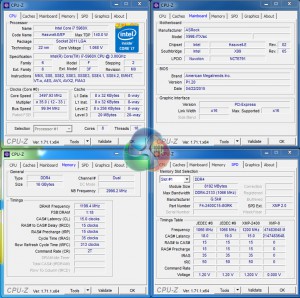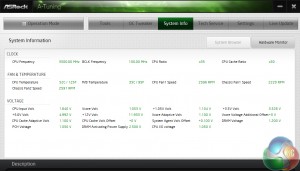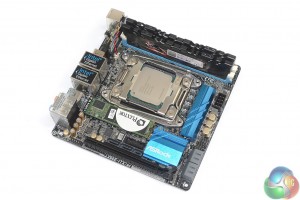We will be outlining the ASRock X99E-ITX/ac motherboard's performance with the Core i7 5960X CPU at its stock frequency (3.5GHz due to forced turbo). Overclocked performance will be outlined later in the review.
Despite the mITX build photographs, our usual X99 motherboard test system is used to keep comparisons as fair as possible. The only variation from the test configuration used for competing motherboards is the forced application of dual-channel memory, rather than quad-channel. We opted for two 8GB 2400MHz DDR4 sticks from G.Skill's Ripjaws4 memory kit that we used here.
Multi-core turbo (MCT) is not applied automatically when XMP is enabled on ASRock’s motherboard. This is good for users who want Intel-standard Turbo Boost profiles and bad for those who want the maximum speed without overclocking. We had to manually enable MCT, forcing our 5960X to a constant 3.5GHz operating frequency, in order to keep comparisons with other motherboards as fair as possible.
ASRock's MCT settings are well-tuned for rapidly adjusting processor and cache frequencies and voltages in order to reduce power consumption. This has the added benefit of throwing less heat into the SFF system when only moderate levels of load are applied. I continue to be impressed by ASRock's use of a ~1.07V CPU VCore with MCT enabled. This is one of the lowest MCT-enabled VCore levels used by any of the board vendors.
X99 Motherboard Test System:
- Processor: Intel Core i7 5960X ES (3.5GHz forced turbo).
- Memory: 16GB (2x8GB) G.Skill Ripjaws4 2400MHz CL15 DDR4 @ 1.20V.
- Graphics Card: Asus R9 280X Matrix Platinum 3GB.
- System Drive: 500GB Samsung 840.
- CPU Cooler: Corsair H100i (with ASRock narrow ILM conversion bracket and modified spacers).
- Case: NZXT Phantom 630.
- Power Supply: Seasonic Platinum 1000W.
- Operating System: Windows 7 Professional with SP1 64-bit.
Compared X99 Motherboards:
- ASRock X99 OC Formula (BIOS v1.16) – with 16GB (4x 4GB) Corsair Vengeance LPX 2800MHz @ 2666MHz 16-18-18-44 DDR4 1.25V
- ASRock X99 Extreme11 (BIOS v1.00) – with 16GB (4x4GB) G.Skill Ripjaws4 2666MHz 15-15-15-35 DDR4 1.25V.
- ASRock Fatal1ty X99 Professional (BIOS v1.50) – with 16GB (4x 4GB) Corsair Vengeance LPX 2800MHz @ 2666MHz 16-18-18-44 DDR4 1.25V
- Asus TUF Sabertooth X99 (BIOS v0216) – with 16GB (4x 4GB) G.Skill Ripjaws4 2666MHz CL15 DDR4 @ 1.20V.
- Asus X99 Deluxe (BIOS 0801) – with 16GB (4x4GB) G.Skill Ripjaws4 3000MHz 15-15-15-35 DDR4 1.35V.
- MSI X99S Gaming 7 (BIOS V17.3B1) – with 3.56GHz CPU and 16GB (4x 4GB) Corsair Vengeance LPX 2800MHz CL16 DDR4 @ 2800MHz 1.20V.
Software:
- ASRock X99E-ITX/ac BIOS v1.20 (latest).
- Catalyst 14.9 VGA drivers.
Tests:
- 3DMark 1.3.708 – Fire Strike (System)
- SiSoft Sandra 2014 SP2 – Processor arithmetic, memory bandwidth (System)
- Cinebench R15 – All-core CPU benchmark (CPU)
- WinRAR 5.10 – Built-in benchmark (CPU)
- HandBrake 0.9.9 – Convert 4.36GB 720P MKV to MP4 (CPU)
- ATTO – SATA 6Gbps, USB 3.0, M.2 transfer rates (Motherboard)
- RightMark Audio Analyzer – General audio performance test (Motherboard)
- Totusoft LAN Speed Test – WiFi speed test, 100MB file transfer to wired ‘server' computer (Motherboard)
- Bioshock Infinite – 1920 x 1080, ultra quality (Gaming)
- Metro: Last Light – 1920 x 1080, high quality (Gaming)
- Tomb Raider – 1920 x 1080, ultimate quality (Gaming)
 KitGuru KitGuru.net – Tech News | Hardware News | Hardware Reviews | IOS | Mobile | Gaming | Graphics Cards
KitGuru KitGuru.net – Tech News | Hardware News | Hardware Reviews | IOS | Mobile | Gaming | Graphics Cards






41$/hour@kitguru
>/